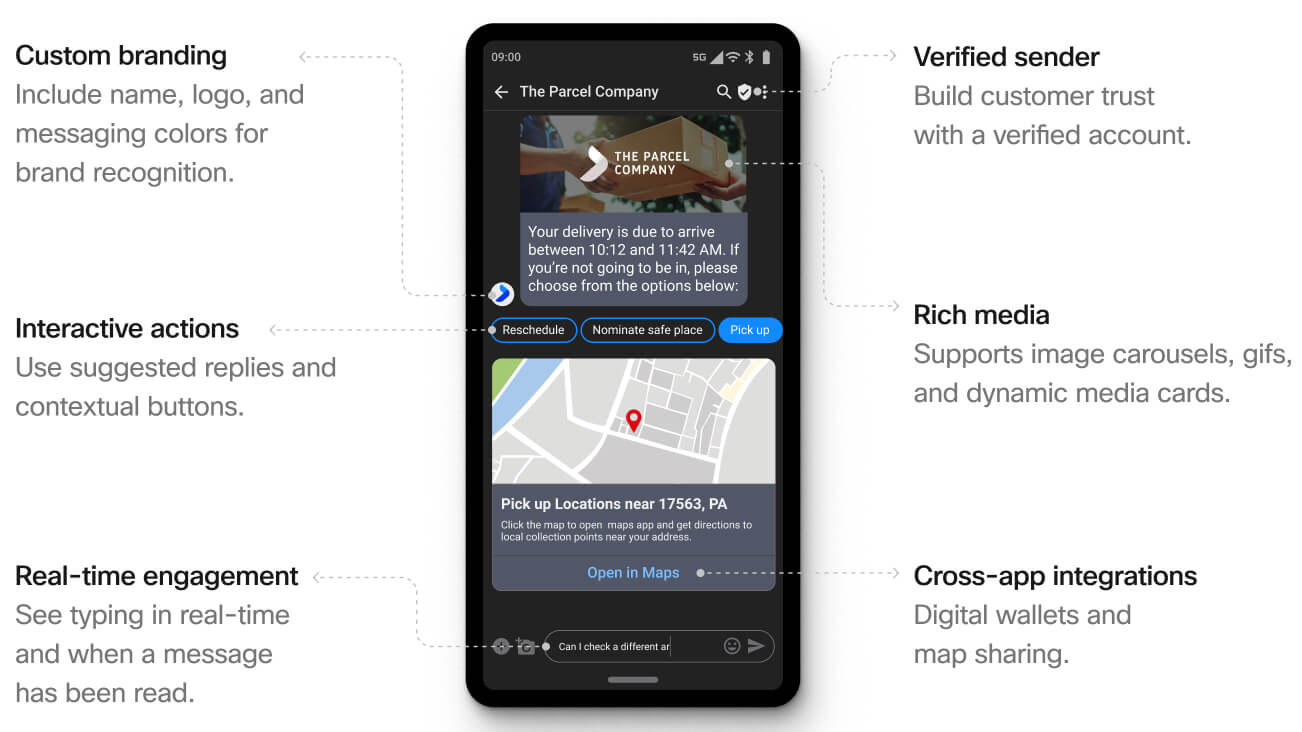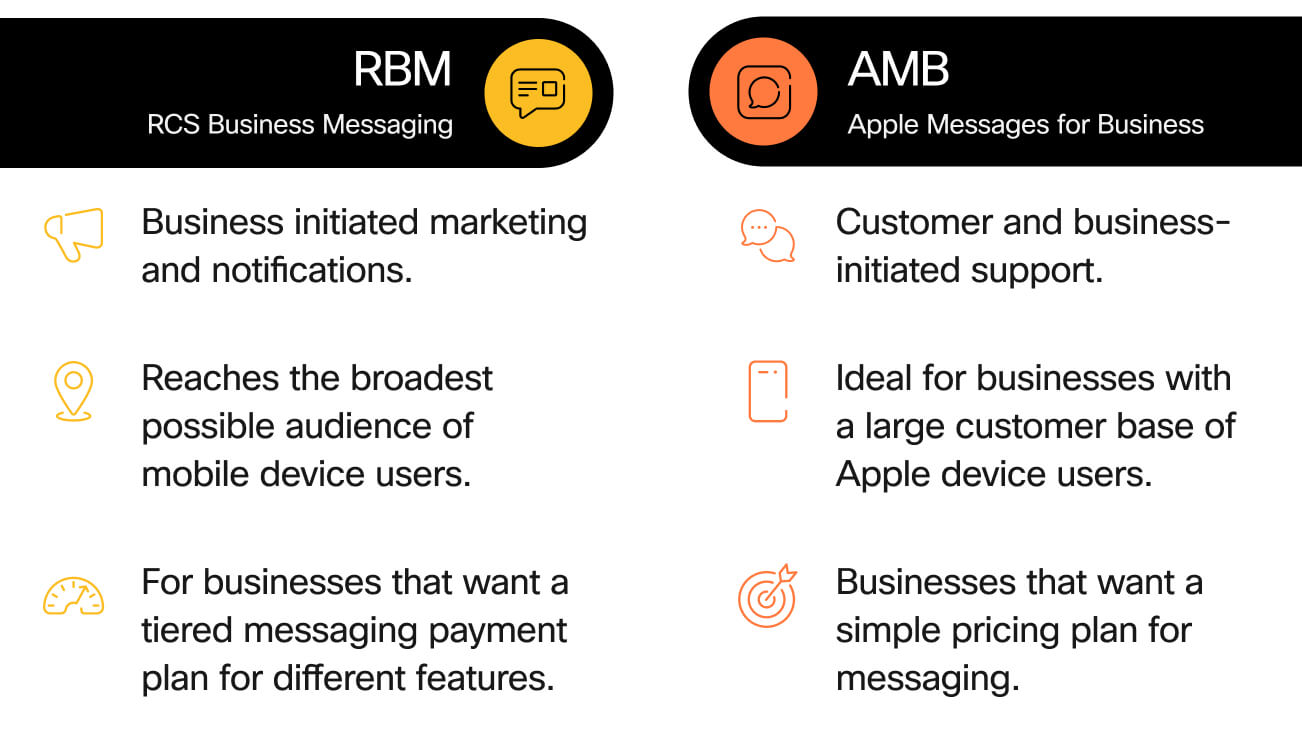RCS vs iMessage: how are they different and when should you use them?
What are the differences between RCS and iMessages? And how should businesses adopt them?
Contents
Rich Communications Services (RCS) have been bringing rich messaging to Android platforms since 2008. But as of September 2024, RCS is also now available for iOS users—sitting side by side with Apple’s iMessage protocol and creating a huge uptick in the number of RCS users.
With 1B RCS users on Android joined by a potential 1.5B new users with Apple devices, RCS now has an even larger audience. However, both channels offer a similar user experience – meaning iMessage still has an important place in any communications strategy.
To help you understand which channel to prioritize and when to use RCS and iMessage to connect with your customers, this article will compare the strengths of each channel to help you make the most of both.
What is Rich Communication Services (RCS)?
While it doesn’t replace the classic SMS protocol (Short Message Service), RCS is a similar type of person-to-person (P2P) messaging that offers rich media and messaging features. It’s similar to over-the-top messaging apps like WhatsApp, but RCS uses each mobile device’s native messaging capabilities, so there’s no need for third-party apps or accounts. And if WiFi or mobile data isn’t available, RCS will automatically fall back to SMS messaging.
If you want to find out more on RCS features check out our RCS messaging and features guide.
What is iMessage?
iMessage offers a similar set of features to RCS, but it’s for Apple device users only. It has a few unique capabilities though, including end-to-end encryption (which is part of RCS on Android, but not supported with RCS on Apple devices currently) and easy integration with iOS devices and native apps like Apple Watch, Safari for example.
RCS vs iMessage features, how do they compare?
Both RCS and iMessages offer rich messaging, but there are a couple of differences between how each operates.
RCS | iMessage | |
|---|---|---|
Rich media support | Image carousels, gifs, and dynamic media cards | Tapbacks, text effects, Live Stickers and other rich media features |
Live engagement indicators | Read receipts and typing indicators in real-time a | Read receipts and typing indicators in real-time |
Security | End-to-end encrypted between Android devices | End-to-end encrypted between Apple devices |
Cross app integrations | Digital wallets and map sharing | Other apps by Apple, e.g. Safari, Apple Pay, Maps |
Fallback channel | SMS - when RCS isn't available | SMS - when iMessage isn't available |
Messaging bubbles | Dependant on device | Blue bubbles |
Is RCS messaging better than iMessage?
While it’s tempting to directly compare RCS and iMessage, the reality is that neither is better than the other. Both appeal to different demographics and dependant on the devices they tend to favour.
iMessage is exclusive to Apple devices and offers a secure, end-to-end encryption and deep integration with other Apple services. Apple holds a bigger market share in the US at around 55% but Android dominates the global market at 70%. So if you are messaging someone who is using an Android device, your message will be in RCS, but if both of you have Apple devices more likely it will be an iMessage.
What is Rich Business Messaging (RBM)?
Rich Business Messaging (RBM) is the business version of RCS, enabling businesses to send verified, secure, branded messages to customers. RBM enables rich, interactive features such as buttons, quick replies, carousels, and rich cards to improve customer experiences.

What is Apple Messages for Business (AMB)?
Apple Messages for Business (AMB) is the business version of iMessage. Exclusive to Apple devices like the iPhone, iPad, and Mac, it offers integrations with Apple’s wider ecosystem so users can interact with businesses, make purchases, and complete secure Apple Pay transactions within their messaging app.
While, previously, AMB could only be initiated by customers getting in touch with businesses, this is now changing to allow for two-way messaging between businesses and consumers.
Differences between RBM vs AMB
RBM | AMB | |
|---|---|---|
Supported platforms | Android, iOS | iOS |
Potential reach | 2.5B users | 1.5B users |
Who initiates the conversation | Businesses and users (in select markets) | Businesses and users |
Price plans | Three tiers with different features | A single fee |
Verified sender marks | Yes | Yes |
Branded messages | Yes | Yes |
Rich media | Yes | Yes |
In-message buttons and suggested replies | Yes | Yes |
Campaign results tracking | Yes | Yes |
Payments integrations | Integrates with a range of payment gateways | Integrates with Apple Pay and Apple Cash |
When should you use RBM and AMB?
Both RBM and AMB standards support key features like rich media and verified sender marks. Beyond these features, the two have different capabilities and potential audiences, making them suited for different use cases.
For example, the two channels have different reaches depending on your customer demographics. If you know your customers are primarily Android users, RCS makes more sense. Meanwhile, an audience of Apple users may prefer iMessage as it integrates with the applications built into their device.

The finer details of how and when to use each channel should be part of a broader omnichannel marketing strategy. Ultimately, businesses should make the most of RCS and iMessage to maximize their reach and take advantage of each channels’ unique features.
Common use cases for RBM
In-message promotions
Send limited time offers in message and enable customers to instantly redeem or save them to a digital wallet. You can also use multimedia components and carousels so customers can browse and purchase products in-channel.
Automated notifications
Share dispatch notifications, recruitment opportunities, fraud alerts, and other time-sensitive notifications. Users can then respond using natural language or by touching suggested reply buttons.
Round-the-clock customer support
With RCS chatbots, customers can troubleshoot product issues, find information like store opening times, request service updates, and manage their user profiles and loyalty programs at any time of day—all within their messaging app.
Feedback requests
Get swift feedback about your products and services by integrating polls into RCS messages. For example, a tour operator could automatically send messages to customers a week after their holiday asking how they felt about the flight, hotel, and other services they booked.
Cross-app integrations
Bring powerful features from other apps into your RCS chats to give users all new options in message. For example, an AI chatbot can help customers book a weekend hotel stay, including travel, all within their messages.
Learn more about other common RCS messaging examples across industries.
Common use cases for AMB
Rapid quote requests
Whether you offer loans and credit cards, or other bespoke services where you need to quote individual prices and terms to customers, AMB makes quotes quick and easy. Customers can fill in their details in message, and you can automatically reply with a bespoke price.
Easy appointment bookings
With AMB’s list and time picker features, it’s easy for customers to book appointments in messages. Especially when integrated with Safari and Apple Maps, it makes a great experience where customers can find your business online and book an appointment within seconds.
Assisted online shopping
Using AMB’s drop down forms and contextual buttons, users can tell you about their preferences and you can automatically send them product images and details and help them complete the transaction in message with Apple Pay. You can even link an App Clip in your message so the customer can complete a standard app-based checkout, without having to download your full app.
Quick answers to common queries
Rather than sending customers to lengthy FAQs, you can prompt them to ask queries in iMessage for more information about products or services. For example, travel companies can offer a drop-down list of potential destinations so customers can get more information about travel times and activities at their destination.
Get the best out of RCS and AMB with Webex Connect
The reality is that it isn’t an either/or situation with RCS and iMessage. To deliver the best customer experiences, it’s both/and. However, managing multiple messaging standards across your customer journeys is no easy task.
Webex Connect can make juggling iMessage, RCS, and their business-focused versions a little easier. An enterprise CPaaS platform, Webex Connect helps organizations build compelling customer journeys by integrating email, SMS, RCS, iMessage, and other common channels into a comprehensive communications strategy.
If you’re ready to deliver new levels of customer engagement and satisfaction, get in touch and speak to one of our experts today.